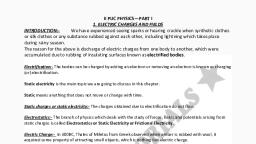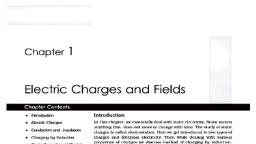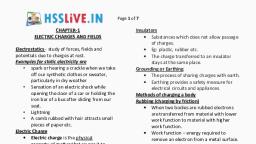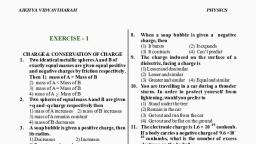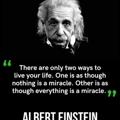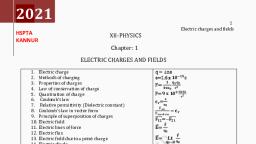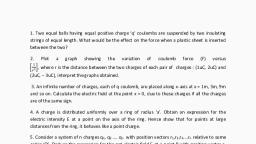Page 1 :
1, , Electrostatics, , Electrostatics, Electrostatics:It is the branch of physics which deals with study of electric charges at rest., Charge:Charge is the property of a particle which causes electric force between the particle and another, particle having charge., or, Charge is the property of electron which causes electric force between two electrons., Charge causes electric field. Thus, the source of electric field is known as charge., → Electric charge is a scalar quantity., → The units of charge are coulomb in S.I. units and statcoulomb in C.G.S. system., → Its dimensional formula is [M0L0T1A1]., Types of charge :There are two types of charge such as positive charge and negative charge. American scientist, Benjamin Franklin chose the charge of electron as negative and charge of proton as positive., Basic law of electrostatics:According to basic law of electrostatics, like charges repel each other while unlike charges attract, each other., Atom and its structure :Atom is the smallest particle of matter which can take part in a chemical reaction. An atom has, two parts such as nucleus and extra-nuclear part., (a) Nucleus :It is the central part of the atom which contains almost whole mass of the atom. The particles, contained in the nucleus are called as nucleons. Mainly there are two types of nucleons., (i) Proton :It is the particle which carries one basic unit of positive charge (+e) and has a mass of 1.6726 × 10- 27, kg., (ii) Neutron :It is an uncharged particle having a mass of 1.6748 × 10- 27 kg., Extra-nuclear part :It is the portion of the atom present outside the nucleus. The particles contained in the extranuclear part are called as electrons., (b) Electron :Electron is the particle having one basic unit of negative charge ( -e ) and has a mass of 9.1× 10- 31 kg., (c) Atomic number (Z) :It is the number of protons ( number of electrons ) contained in an atom., (d) Charge on nucleus :As there are ‘Z’ number of protons present inside the nucleus, the charge on nucleus is ‘+Ze’., (e) Charge on the atom :Since there are equal number of protons ( total charge = + Ze ) and electrons ( total charge = -Ze ),, so there is no resultant charge on an atom. Thus, an atom is always electrically neutral., Charging a body:- ( Electrification ), The process of developing charge on an uncharged body is called as electrification or charging a, body. It can be done by the following three processes., (i) Charging by friction:The process of developing charge on a body by rubbing it with another body is called as charging by, friction., When a body ‘A’ is rubbed with another body ‘B’, some electrons of ‘A’ are transferred to ‘B’. In, this process, the body ‘B’ acquires a negative charge while the body ‘A’ acquires equal amount of +ve, charge. Thus, the bodies ‘A’ and ‘B’ become charged.
Page 2 :
2, , Electrostatics, Example :(i) When a glass rod is rubbed with silk, it acquires a positive charge because electrons are transferred, from glass rod to silk. The silk acquires an equal amount of –ve charge as it gains equal number of, electrons., (ii) When amber (hardened sap of a kind of pine tree) is rubbed with woolen cloth, it acquires a negative, charge, while the woolen cloth acquires a +ve charge., Thus, when we rub a pair of predestined substances, one substance acquires a +ve charge, while the other acquires a -ve charge., Following table gives a number of predestined pairs of substances along with the nature of the, charge developed upon them on rubbing., SL. No. Pair, Positively charged, Negatively charged, 1, Glass, silk, Glass, silk, 2, Cat skin, Ebonite, Cat skin, Ebonite, 3, Flannel, Ebonite, Flannel, Ebonite, 4, Woolen cloth, Amber, woolen cloth, Amber, 5, Woolen cloth, Rubber, woolen cloth, rubber, 6, Woolen cloth, Plastic, woolen cloth, plastic, 7, dry hair, Comb(plastic), dry hair, comb, (ii) Charging by conduction :The process of developing charge on an uncharged body by keeping, it in contact with a charged body is called as charging by conduction., When a +vely charged body ‘A’ is brought in contact with an, uncharged or neutral body ‘B’, some electrons of ‘B’ flows to ‘A’. As a, result, positive charge of ‘A’ gets reduced while an equal amount of, positive charge appears on ‘B’. On separating the two bodies, both the, bodies are found to be positively charged., (iii) Charging by induction :The process of developing positive and negative charges at the two, ends of an uncharged body, when a charged body is brought near it is, called as charging by induction., When an uncharged body ‘B’ is brought near a positively charged, body ‘A’, negative charge gets induced on the portion of body ‘B’ nearer to, ‘A’ while positive charge gets induced on the farther end. If we connect the, farther end of ‘B’ with earth, electrons flow from earth to body B in order, to neutralize the free induced positive charge. On breaking the connection, of body ‘B’ from earth, it becomes –vely charged., Important notes :A positively charged body has lost some electrons and hence its mass reduces slightly. On the, other hand, a negatively charged body has gained some electrons and hence its mass increases slightly., Characteristics of electric charge :(i) Quantization of charge or discrete nature of charge:The charge on a body is not continuous, but it is an integral multiple of basic unit of charge. Basic, unit (fundamental unit) of charge is the smallest amount of charge which has free existence and is, represented as ‘e’., Thus charge on a body can be represented as, q = ne, where ‘n’ is an integer., The basic unit of charge is the magnitude of charge of an electron or proton. The charge of an, electron is represented as ‘-e’ and charge of proton as ‘+e’., The value of basic unit of charge is, e = 1.6× 10 -19 C., If a body contains 𝑛1 numbers of protons and 𝑛2 numbers of electrons, the total amount of charge, on the body is given by, q = 𝑛1 𝑒 + 𝑛2 (-e), q = (𝑛1 − 𝑛2 ) e, The fact that charges on any body are always integral multiple of basic unit of charge is known, as quantization of charge.
Page 3 :
3, , Electrostatics, Important notes :The cause of quantization of charge is that only integral number of electrons are transferred from, one body to another body., Problems Based on quantization of charge, Formula used, 1. q = ne, 2. Mass transferred, m = nme, Q. What is the value of charge on a body which carries 20 excess electrons ?, Q. How many electrons put together will make one coulomb of charge ?, Q. A body is found to have +10-9 C of charge. Find how many electrons have been removed from it ?, Q. Is a charge of 5.8 × 10−18 C possible ?, Q. Estimate charge on all the electrons in a 10 g Cu penny., (4.412 × 105 C ), Q. A polythene piece rubbed with wool is found to have a negative charge of 3.2 × 10−7 C. (i) Estimate, the number of electrons transferred. (ii) Is there a transfer of mass from wool to polythene ? If so,, calculate the mass transferred., ( 𝑖. 2 × 1012 , 𝑖𝑖. 1.82 × 10−18 kg), (ii) Conservation of charge :Law of conservation of charge states that the total charge (algebraic sum of +ve and –ve charges ),, in an isolated system always remains constant. In other words, charge can neither be produced nor, destroyed., Examples :(1) When a glass rod is rubbed with silk, the glass rod acquires positive charge and the silk acquires an, equal amount of negative charge. Thus, the total amount of charge in the isolated system of glass rod and, the silk remains the same ( zero ) before and after rubbing., (2) In radioactive decay, when an 𝛼-particle ( 2 𝐻𝑒 4 ) is emitted from the nucleus of Uranium, ( 92 𝑈 238 ), a new element Thorium ( 90 𝑇ℎ234 ) is formed. This reaction is represented as, , → 90 𝑇ℎ234 + 2 𝐻𝑒 4, So, the total charge on nucleus of Uranium ( + 92e ) is equal to the sum of the charges on, nuclei of Thorium (+90e) and 𝛼-particle (+2e ). Hence, the charge on nucleus ( +92e) is the same, before and after the reaction., 92 𝑈, , 238, , (iii) Additive nature of charge:Total charge on an extended body is equal to the algebraic sum of charges located at different parts, or regions of the body., (iv) Invariance of charge :The amount of charge on a body does not depend upon the velocity of the body., (v) Transference of charge :When a body having higher degree of electrification (potential) is connected to another body, having lower degree of degree of electrification (potential), charge flows from the body having higher, potential to the body having lower potential., Some terms connected with charge:(1) Point charge:A point charge is a charged body whose dimensions are very small as compared to the distance of a, point, where we want to analyze its effect., (2) Permittivity:-(ε), It is a characteristic of a medium which determines the capability of the medium to convey the, effect of a charge from one point to another point in the same medium., or, It is the property of the medium which affects the magnitude of force between two charges present, in the medium., → Greater the value of permittivity, smaller will be the effect of charge at a given point. Its value varies, from medium to medium., Absolute permittivity :- (ε0), It is the permittivity of free space or air medium. Its value is, ε0 =8.854 × 10 -12 C2 N-1m -2, Relative permittivity :- (εr), It is the ratio between the permittivity of a medium to the permittivity of free space., εr = ε / ε0, or, ε = ε0 εr
Page 5 :
5, , Electrostatics, Substituting the value of 𝑟12 in equation(1), we get, 𝑞1 𝑞2, 𝐹 21 =k |𝑟 −𝑟, (𝑟2 - 𝑟1 ) -------------------(2), |3, 2, , 1, , Similarly, the force 𝐹 12 exerted on the charge q1 by charge q2 is given by, 𝑞1 𝑞2, 𝐹 12 =k |𝑟 −𝑟, (𝑟1 - 𝑟2 ), -------------------(3), |3, 1, , 2, , From equation (2) and (3), we get, 𝐹 21 = - 𝐹 12, Hence action = - reaction, Thus, force on charge q1 due to charge q2 is equal and opposite to the force on charge q2 due to charge q1., Properties of Coulomb’s law :→ Coulomb’s law is an experiment based law., → Coulomb’s law is strictly valid for point charge only., → Coulomb’s force between two point charges is a mutual interaction., → Coulomb’s force is not affected by the presence of other charges in the neighbourhood., → It holds good for very large and very small distance up to 10-13 m. For the distance less than 10-13 m,, Coulomb’s force breaks down due to predominance of nuclear forces., → Coulomb’s force is attractive in nature for dissimilar charges while it is repulsive in nature for similar, charges., → It is a central force i.e. it acts along the line joining the two charges., → The magnitude of force depends upon the magnitude of charges, separation between them and upon, the nature of medium between them., → Coulomb’s force is conservative in nature., Units of ε (or ε0):According to Coulomb’s law,, 1, 𝑞 𝑞, F = 4 πε 𝑟1 2 2, 1, , 0, , 𝑞 𝑞, , 1 2, or, ε0 =, 4π, 𝐹𝑟 2, In S.I. units the unit of charge is coulomb., , 𝑐𝑜𝑢𝑙𝑜𝑚𝑏 ×𝑐𝑜𝑢𝑙𝑜𝑚𝑏, , [ε0] = 𝑛𝑒𝑤𝑡𝑜𝑛 ×𝑚𝑒𝑡𝑟𝑒 2 = C2 N-1m -2, Dimensions of ε (or ε0):[ε0] =, , (𝑐ℎ𝑎𝑟𝑔𝑒)2, 𝑓𝑜𝑟𝑐𝑒 × 𝑑𝑖𝑠𝑡𝑎𝑛𝑐𝑒 2, , =, , [A1 T1 ]2, [M1 L1 T−2 ]×[ L2 ], , = [𝑀−1 𝐿−3 𝑇 4 𝐴2 ], , So, the dimensions of ε0 are -1, -3, 4 and 2 in mass, length, time and electric current respectively., Units of charge:(i) In C.G.S. system:In C.G.S. system, the electrostatic unit of charge is called statcoulomb or e.s.u. of charge., According to Coulomb’s law,, 𝑞 𝑞, F = 122, (for air medium), 𝑟, If q1=q2 =q, r = 1 cm and F = 1 dyne,, 𝑞2, , 1 = 12, or q2 = 1 or q = ±1, Hence one statcoulomb is that amount of charge which when placed, in air at a distance of 1 cm, from an equal and similar charge, repels it with a force of 1 dyne., In C.G.S. system, the electromagnetic unit of charge is called as abcoulomb (e.m.u. of charge)., 1, 1 coulomb = 10 abcoulomb, 1 abcoulomb = 10 coulomb, (ii) In S.I. units:In S.I. units, the unit of charge is called coulomb., 1, 𝑞1 𝑞2, F =, (for air medium), 2, 4 πε0, , But the value of, , 𝑟, 1, 4 πε0, , = 9 × 10 9 Nm2 C-2
Page 6 :
6, , Electrostatics, 𝑞 𝑞, , 1 2, Hence, F = 9 × 10 9, (for air medium), 𝑟2, If q1=q2 =q, r = 1 m and F = 9 × 10 9 N, then, 9 × 10 9 =9 × 10 9 q2, or, q = ± 1 coulomb, Thus, one coulomb of charge is defined as that amount of charge which when placed, in air, at a, distance of 1 metre from an equal and similar charge repels it with a force of 9 × 10 9 newton., Important Note, → One coulomb of charge is the charge acquired by 6.25 × 10 18 number of electrons., Relation between coulomb and statcoulomb :Let 1 coulomb = x statcoulomb, Consider two charges each of magnitude one coulomb separated by a distance 1 metre in free space., q1 = q2 = 1 coulomb, We know that in S.I. units,, 1, 𝑞1 𝑞2, F =, (for air medium), 2, , 4 πε0, , or, , 𝑟, , 𝑞1 𝑞2, 𝑟2, 1×1, 9, 12, , F = 9 × 10 9, , or, F = 9 × 10, N = 9 × 10 9 N, …………………(4), In C.G.S. system,, 𝑞1 = 𝑞1 = 𝑥 statcoulomb and r = 1m = 100 cm, According to Coulomb’s law, for C.G.S. system, 𝑞 𝑞, F = 𝑟1 2 2 dyne, (for air medium), 𝑥 ×𝑥, dyne, 1002, 2, 𝑥, =, dyne, 104, 2, 𝑥, 𝟏, = 104 𝟏𝟎𝟓, 𝑥2, =, N, 109, , or, , F=, , or, , F, , or, , F, , newton, , (since 1N =105 dyne), , or, F, ………………………………..(5), From equation (1) and (2), we have, 𝑥2, 109, , 9 × 10 9, or, x2 = 9 × 1018, or, x =3 × 10 9, Hence 1 coulomb = 3 × 10 9 statcoulomb, Sample problems :Q. Find the force between two protons placed in free space separated by a distance of 20cm., (5.76 ×10-27N), Q. Two equal and similar charges 0.03 m apart, in air medium, repel each other with a force 4.5, kg wt. Find the charge in coulomb., (21 × 10−7 C ), Q. Two equal conducting spheres of negligible size are charged with 16.0×10-14 and -6.0 × 10-14 C, respectively and are placed 0.20 m apart. Then they are moved to a distance of 0.5 m., (a) compare the forces between them in two positions., (b) The spheres are connected by a thin wire. What force does each now exert on the other ?, ( a. 6.25, 8.29 × 10−17 N ), Q. The force between two electrons when placed in air is equal to 0.5 times of the weight of an, electron. Find distance between two electrons., Q. An electron and a proton are at a distance one meter apart. Find the electric force between them in S.I., and C.G.S. system. Hence find the relation between newton and dyne., Q. The electrostatic force of repulsion between two positively charged ions carrying equal charge is 3.7 ×, 10-9 N, when they are separated by a distance 5 𝐴0 . How many electrons are missing from each ion ?, Q. A charge q is placed at the centre of the line joining two equal charges Q. Show that the system of three, charges will be in equilibrium if q = -Q/4., Q. Two point charges, having a total charge Q, are distance ‘x’ apart. find the value of each charge so that, the force they exert on one another is maximum., ( q= Q/2), Dielectric constant :Consider two charges q1 and q2 placed at a distance ‘r’ apart from each other in a medium other, than free space. The force between them is given by, =
Page 7 :
7, , Electrostatics, 1 𝑞 𝑞, , Fm = 4πε 𝑟1 2 2, ------------ (1), where ε is the permittivity of the medium., The force between the same two charges held at the same distance apart in vacuum or air medium, is given by, 1 𝑞 𝑞, 𝐹0 = 4 πε 𝑟1 2 2, ------------ (2), 0, , Now dividing equation (2) by equation (1), we get, 𝐹0, ε, = = εr or K, 𝐹𝑚, , ε0, , where ‘K’ is called dielectric constant of the medium., So, dielectric constant of a medium is defined as the ratio of the force between two charges, separated by some distance in air medium to the force between the same two charges separated by the, same distance in that medium., or, Dielectric constant of a medium is also defined as the ratio of the permittivity of the medium to, the permittivity of the free space., Hence dielectric constant of a medium is equal to its relative permittivity., Superposition principle :- ( Net force on a charge due to a number of charges ), Electrostatic force on a given charge due to a large number of other charges can be obtained by, applying of principle of super position., According to superposition principle, total force on any charge due to a number of other charges is, the vector sum of all the forces on that charge due to the other charges. The force between any two, charges is independent of presence of other charges., Consider a system of charges q1, q2, q3,……qn situated at points with position vectors 𝑟1, 𝑟2,, 𝑟3,….., 𝑟n respectively., Let 𝐹 o be the total force on a test charge q0 situated, at a point having position vector, 𝑟0., According to principle of superposition, the total, force on q0 is given by, 𝐹 o = 𝐹 01 + 𝐹 02 + 𝐹 o3 + ……. +𝐹 on, where 𝐹 01 = force on q0 due to charge q1, 𝐹 02 = force on q0 due to charge q2, 𝐹 03 = force on q0 due to charge q3, 𝐹 0n = force on q0 due to charge qn, Sample problems :Q. Three equal charges 1𝜇C each are placed at the three corners of an equilateral triangle of sides 3cm., Find the force experienced by each charge due to the other two charges., Q. Three point charges +2 𝜇C, -3 𝜇C and -3 𝜇C are placed at the vertices A, B, C respectively of a, equilateral triangle of side 20cm. What should be the sign and magnitude of charge to be placed at the, mid point M of side BC so that the charge at A remains in equilibrium. [ CBSE 2005], Q. Two identical metallic spheres having unequal opposite charges are placed at a distance of 0.5 m, apart in air. After bringing them in contact with each other, they are placed at the same distance, apart. Now the force of repulsion between them is 0.108 N. Calculate the final charge on each of them., Q. Two identical charges, Q each are placed at a distance ‘r’ from each other. A third charge ‘q’ is placed, on the line joining the above two charges such that all the three charges are in equilibrium. What is the, magnitude, sign and position of charge ‘q’ ?, Q. A small brass sphere having a positive charge of 1.7 × 10−8 C is made to touch another sphere of same, radius having a negative charge of 3× 10−8 C. Find the force between them when they are separated by, a distance of 20 cm. What will be the force between them when they are immersed in a oil of dielectric, constant 3 ?, Q. Four equal point charges each 16 𝜇C are placed at the four corners of a square of side .2 m. Calculate, the force on any one of the charges., Some important terms in electrostatics:(i) Source charge:It is a charge body or distribution of charges whose electrostatic effect is to be analysed at a, point away from it., (ii) Test charge:-
Page 8 :
8, , Electrostatics, To determine the effect of a source charge at any point, we have to place a small charge at that, point. This small charge is called as test charge., (iii) Source point:The point where source charge is located is called as source point., (iv) Observation point:The point where test charge is located is called observation point., Electric Field:When an electric charge is placed at a point, the properties of space around the charge get, modified. The modified space around an electric charge where its influence can be realized is called as, electric field., or, The space around a charge in which any other charge experiences electrostatic force is called as, electric field of the charge., Electric field intensity or strength of electric field :- ( 𝐸⃗ ), Electric field intensity, at any point, in an electric field is defined as the force experienced by a unit, positive charge placed at that point. It is represented by 𝐸⃗ ., Suppose a positive test charge ‘q0’ experiences a force ‘𝐹 ’, when placed at an observation point ‘P’., Electric field intensity at the point ‘P’ is given by, 𝐹, 𝐸⃗ =, 𝑞0, , Electric field intensity, 𝐸⃗ is a vector quantity and the direction of electric field, 𝐸⃗ is along 𝐹, ⃗, i.e. 𝐸 is directed along the direction in which a unit positive charge would move, if it were allowed to, move freely., Dimensions of E :𝐹, Electric field intensity,, E =, 𝑞0, , [F] = [M1L1T-2] , [q0] = [A1T1], [E] =, , [M1 L1 T−2 ], [A1 T1 ], , or, [E] = [𝑀1 𝐿1 𝑇 −3 𝐴−1 ], So, the dimensions of electric field intensity are 1, 1, -3 and -1 in mass, length, time and electric, current respectively., Units of E :𝐹, Electric field intensity,, E =𝑞, 0, , (i) In C.G.S. system (e.s.u.), the units of electric field intensity is dyne /statcoulomb, (ii) In S.I. units, the units of electric field intensity is newton /coulomb, Electric field intensity due to a point charge :Consider a point charge ‘q’ situated at a point ‘O’ in free space., Suppose a test charge q0 be placed at point ‘P’ at distance ‘r’ from ‘O’. Force acting on q0 is given by, 1, 𝑞𝑞, F = 4 πε 𝑟20, (for air medium), 0, , Electric field at P due to q is, , or, , E = F / q0, 1, 1, E = 𝑞 × 4 πε, , or, , E=, , 0, , In vector form ,, Electric field intensity,, , 𝐸⃗ =, =, , 1, 4 πε0, , 𝑞, 𝑟2, , 0, , 𝐹, 𝑞0, 1, 𝑞, 4 πε0 𝑟 2, , 𝑞𝑞0, 𝑟2, , 𝑟̂, , where 𝑟̂ is the unit vector of from ‘O’ to ‘P’., Sample problems :Q. Calculate the electric field strength just required to support a water drop of mass 10−3 kg and having a, charge 1.6 × 10−19C., Q. Calculate the magnitude and direction electric field which keeps a proton just floating., Q. A charge of +5 𝜇C experiences a force of 1 mN in an electric field. What is the magnitude of electric
Page 9 :
9, , Electrostatics, field at that position ?, ( 2 × 102 𝑁𝐶 −1 ), −19, Q. An oil drop of mass 1 g and having a charge 2 × 10 C is suspended in a box. What is the magnitude, of electric field in the box ?, ( 4.9 × 103 𝑁𝐶 −1 ), Q. How many electrons should be removed from a coin of mass 1.6 g, so that it may float in a electric field, of 109 𝑁𝐶 −1 ?, (9.8 × 107), 4, Q. A charged oil drop is suspended in a uniform electric field 27.5 × 10 𝑣𝑜𝑙𝑡 𝑚−1 so that it neither rises, nor falls. Find the charge on the drop, given mass of the drop is 9 × 10−15 kg. ( Neglect air resistance ), 1, Q. A tree pith ball of mass 6 g carries a positive charge of (3) × 10−15 C. What is the nature and magnitude, of the charge that should be given to a second pith ball fixed 5 cm vertically below the former pith ball, so that the upper pith ball is stationary ?, ( 4.9 × 10−7 C ), Q. Two point charges +16 𝜇C and -9 𝜇C are placed 0.08 m apart in air. Determine the position of the, point at which resultant electric field is zero., ( 0.24 m from the charge -9 𝜇C ), Electric lines of force :- ( Electric field lines ), Electric line of force is defined the path along which a unit positive charge would move, if it were, allowed to move freely in an electric field., or, The path described by a unit positive charge in an electric field is called as electric line of force., → The strength of electric field (magnitude of electric field intensity ) at any point is equal to the number, of lines of force crossing through a unit area held normal to the lines of force at that point., Properties of lines of force:(1) Electric lines of force start from +ve charge and end at –ve charge. Hence the lines of force are, directed away from a positive charge and are directed towards a negative charge., , (2) Tangent drawn at any point to the line of force gives the direction of electric field intensity at that, point., (3) Two electric lines of force never intersect each other. Because if two lines of force will intersect each, other, then at the point of intersection, two tangents can be drawn. This indicates two directions of, electric field intensity at that point. But electric field intensity can never have two directions at a, single point. Hence two lines of force never intersect each other., (4) The region where the lines of force are closer, the electric field is strong and the region where the lines, of force are far apart, the electric field is weak., (5) The lines of force tend to contract longitudinally or lengthwise. Due to this property, two unlike, charges attract each other., (6) The lines of force tend to repel each other, laterally. Due to this property, two like charges, repel each other., (7) The lines of force meet the surface of a, spherical conductor normally., (8) Lines of force never pass through a, conductor., (9) 4π numbers of lines of force starts from a, unit charge., Uniform electric field :An electric field is said to be uniform, if electric field intensity at all the points in the field is the same., It is represented by parallel lines of force., Non-uniform electric field :An electric field is said to be non-uniform, if electric field intensity is different at different points in, the electric field. It is represented by either divergent or convergent lines of force.
Page 10 :
10, , Electrostatics, Representation of electric field:An electric field can be represented by a set of lines of force. Figure given bellow represents, different types of electric fields., (i) Figure-1 represents a uniform field, acting perpendicular to the plane of the paper and directed, , outwards., (ii) Figure-2 represents a uniform field, acting perpendicular to the plane of the paper and directed, inwards., (iii) Figure-3 represents a strong uniform field, in the plane of the paper and directed from left to right, where the source is at infinity., (iv) Figure-4 represents a weak uniform field, in the plane of the paper and directed from left to right, where the source is at infinity., (v) Figure-5 represents a non-uniform field having its source (positive) towards left., (vi) Figure-6 represents a non-uniform field having its source (negative) towards right., Electric dipole :An electric dipole consists of two equal and opposite charges separated by a small distance., Let AB be an electric dipole consisting of two charges +q and –q., The middle point of the line joining the two charges is called as the centre of the dipole. It, is represented by ‘O’., The distance between the two charges is called dipole length. It is, generally represented by “2Ɩ”., Axial line:A line joining the two charges and passing through the centre of the, dipole is called as the axial line., Equatorial line :A line passing through the centre of the dipole and perpendicular to, the axial line is called as equatorial line of the dipole., Ideal electric dipole :An ideal electric dipole is a dipole whose magnitude of charge tends to infinity while the, separation between the two charges tends to zero., Electric dipole moment :Electric dipole moment or strength of an electric dipole is defined as the product of any one of the, charges and distance between them., or, Electric dipole moment of an electric dipole is defined as the product of either charge and the, length of the dipole., P = q. 2 𝑙, → It is a vector quantity and directed from -ve charge to +ve charge., 𝑃⃗ = q. 2𝑙, where ‘2𝑙 ’ represents the vector distance from –q to +q., → Electric dipole moment is the measure of the strength of the electric dipole., Electric field intensity at any point on the axial line of an electric dipole :( at end-on position or tan-A position), Let us consider a dipole AB, consisting of two charges -q and +q situated at A and B respectively., Let ‘O’ be the centre of the dipole and ‘2𝑙’ be its dipole length., , So, and, , AB = 2 𝑙, OA=OB= 𝑙
Page 13 :
13, , Electrostatics, Force exerted on charge ‘+q’ by the electric field is given by, 𝐹 1 = +q𝐸⃗, Force exerted on charge ‘-q’ by the electric field is given by, 𝐹 2 = -q𝐸⃗, Since these two forces are equal in magnitude, but opposite in direction having different lines of, action, they constitute a couple., The couple moment or the torque on the dipole is given by the product of magnitude of either, forces and perpendicular distance between the two forces., i.e. 𝜏 = qE × AC, or 𝜏 = qE × ABsin 𝜃, or 𝜏 = qE × 2𝑙. sin 𝜃, = q.2l . E sin 𝜃, or 𝜏 = PE sin 𝜃, where P = q. 2l = dipole moment of the dipole., If E=1, sin 𝜃 =1 i.e. 𝜃 =90°, then 𝜏 =P, Thus, electric dipole moment of an electric dipole is defined as the torque acting on it, when it is, placed at right angle to the direction of uniform electric field of unit strength., In vector form,, 𝜏 = 𝑃⃗ × 𝐸⃗, Sample problems :Q. An electric dipole consist of two opposite charges of magnitude 1/3 10−7C, separated by 2 cm. The, dipole is placed in an external field of 3 × 107 𝑁𝐶 −1. What maximum torque does the electric field exert, on the dipole ?, Q. An electric dipole consisting of an electron and a proton separated by a distance 4 × 10−10 m is, situated in a electric field of intensity 3 × 105 𝑁𝐶 −1 at an angle 300 with the field. Calculate the dipole, moment and torque acting on it., Q. An electric dipole consists of two + 2e and -2e separated by 0.78 nm. It is in an electric field of strength, 3.4 × 105 𝑁𝐶 −1 . Calculate the magnitude of the torque on the dipole when the dipole moment is, (a) parallel to, (b) perpendicular to and (c) antiparallel to the electric field., Continuous charge distribution :There are three types of charge distributions such as, (i) Linear charge distribution, (ii) Surface charge distribution, (iii)Volume charge distribution, Depending upon the types of charge distribution there are three types of charge densities such as, (i) Linear charge density (𝜆), (ii) Surface charge density (𝜎), (iii) Volume charge density (𝜌), (1) Linear charge distribution :If the total charge is distributed over the length of the conductor, such charge distribution is called, linear charge distribution., Linear charge density :It is defined as the charge per unit length of the conductor. It is denoted by λ., Let ‘q’ be the charge distributed over a conductor of length ‘l’., 𝑞, Linear charge density, λ = 𝑙, (2) Surface charge distribution :If the charge is distributed over the surface of a body, such a charge distribution is called as surface, charge distribution., Surface charge density :- (𝜎), It is defined as the charge distributed over unit surface area of the body. It is represented by 𝜎., Let ‘q’ be the charge distributed over area ‘A’ of the body, 𝑞, Surface charge density , 𝜎 =𝐴, (3) Volume charge distribution :If the charge is distributed over the volume of a cubical body, then such charge distribution is, called as volume charge distribution.
Page 14 :
14, , Electrostatics, Volume charge density :It is defined as the charge distributed over unit volume of a body. It is represented by 𝜌., Let ‘q’ be the charge distributed over the volume ‘V’ of the cubical body, 𝑞, Volume charge density, 𝜌 =𝑉., Vectorial representation of area :Surface area of a given surface enclosing a certain volume is treated as a vector. The length the, vector represents magnitude of the area vector and its direction is along the outward drawn normal., Consider a small area element ‘ds’ of a closed surface as shown in figure., This small area element can be represented by a vector, ‘d𝑠’. The magnitude of, the area vector ‘d𝑠’ is ‘ds’ and its direction is along the outward drawn normal., Thus the area element vector ‘d𝑠’ can be written as, d𝑠 = ds 𝑛̂, where 𝑛̂ is a unit vector along outward drawn normal to the area element, ds., Electric flux :Electric flux through a given area in an electric field represents the total number of electric lines, of force passing through the area., Consider a closed surface ‘S’ situated in a uniform electric field 𝐸⃗ ., Suppose the surface is divided into large number of elementary areas each of surface area equal to, dS., Electric flux ‘𝛷𝐸 ’ for a surface placed in an electric field is the sum of the dot products of 𝐸⃗ and d𝑆 for, all the elementary areas constituting the surface., , If the elementary areas are taken to be infinitely small (i.e. dS→ 0), then, 𝛷𝐸 =∫ 𝐸⃗ . 𝑑𝑆, 𝑠, , where ∫𝑠, , represents the surface integral, , Since 𝑑𝑆 = dS 𝑛̂, where 𝑛̂ =unit vector along a direction perpendicular to dS, so, 𝛷𝐸 =∫ 𝐸⃗ . 𝑛̂ dS, 𝑠, , or, , 𝛷𝐸 =∫𝑠 𝐸𝑑𝑆 𝑐𝑜𝑠𝜃, , where 𝜃 is the angle between 𝐸⃗ and 𝑛̂., Special cases :(i) when 𝜃 < 90°, i.e. 𝜃 is acute, cos 𝜃=+ve, Hence 𝛷𝐸 is positive., (ii) When 𝜃 = 900 , then 𝛷𝐸 =0,, Hence, no flux is linked with the surface when it is placed parallel to the direction of electric field., (iii) When 𝜃 > 900 and 𝜃 < 1800 , then cos𝜃 = -ve,, Hence 𝛷𝐸 = -ve., → Electric flux is a scalar quantity., Units of electric flux ( 𝛷𝐸 ):(i) In S.I. units, the unit of 𝛷𝐸 is Nm2C-1., (ii) In C.G.S. system, the unit of 𝛷𝐸 is dyne cm2 (statcoulomb)-1, Dimensions of 𝛷𝐸 :The dimensional formula of 𝛷𝐸 is
Page 15 :
15, , Electrostatics, [𝛷𝐸 ] = [M1L3T-3A-1], So, the dimensions of electric field intensity are 1, 3, -3 and -1 in mass, length, time and electric current, respectively., Gauss’s law (Gauss’s theorem) :1, It states that, the total electric flux through a closed surface is ε times of the total charge enclosed, by the closed surface., Let 𝛷𝐸 = electric flux linked with a closed surface, and q = amount of charge enclosed by the surface., According to Gauss’s law,, 1, 𝛷𝐸 =, q, , 0, , ε0, , But, 𝛷𝐸 =∮(𝐸⃗ .𝑛̂) dS, So 𝛷𝐸 = ∮(𝐸⃗.𝑛̂) dS =, , 1, ε0, , q, , This is mathematical form of Gauss’s law., Derivation of Coulomb’s law from Gauss’s law:Let us consider a point charge +q, situated at a point ‘O’ in free space., Imagine a sphere of radius ‘r’ and having its centre at ‘O’., Suppose ‘P’ be an observation point on the surface of the sphere so that the distance of P from the point, ‘O’ is ‘r’ ., Here the electric field 𝐸⃗ is normal to the surface of the sphere at all the points and hence, the angle, between 𝐸⃗ and d𝑆 is zero., Electric flux linked with the surface,, 𝛷𝐸 =∫ 𝐸⃗ . 𝑑𝑆, 𝑠, , or, , 𝛷𝐸 =∫𝑠 𝐸𝑑𝑆 𝑐𝑜𝑠𝜃, , or, , 𝛷𝐸 =∫𝑠 𝐸𝑑𝑆 𝑐𝑜𝑠0, , or, 𝛷𝐸 = 𝐸 ∫𝑠 𝑑𝑆, or, 𝛷𝐸 = E S, or, 𝛷𝐸 = E 4𝜋𝑟 2, According to Gauss’s law,, 𝛷𝐸 =, , ( since surface area of sphere = 4𝜋𝑟 2 ) ---------(1), 1, ε0, , q, , -------------(2), , Comparing equation (1) and (2), we get,, 1, E 4𝜋𝑟 2 = ε q, or, , E=, , 1, 4 πε0, , 0, , 𝑞, 𝑟2, , If 𝑞0 is the test charge placed at P, force acting on it, F= 𝑞0 E, 1, 𝑞𝑞0, or, F =, 2, 4 πε0 𝑟, , This is Coulomb’s law in electrostatics., Gaussian surface :Any closed surface enclosing a charge is called as the Gaussian surface of, that charge., Application of Gauss’s law :Electric field due to an infinite flat conductor carrying charge :Let us consider a flat plane conductor ABCD carrying charge and having surface charge density, 𝜎., The charge resides on both the sides of the conductor., Let ‘p’ be the observation point on at distance ‘r’ from the plane., Imagine a cylinder of cross sectional area ‘S’ and length ‘2r’ drawn symmetrically through the, sheet such that the point, P lies on one of its flat surfaces., For the curved surface of the cylinder, electric field 𝐸⃗ and unit vector along outward normal, 𝑛̂ are, perpendicular to each other. Therefore, electric flux through the curved surface is zero. For the flat, surfaces at P and Q, 𝐸⃗ and 𝑛̂ are parallel to each other.
Page 16 :
16, , Electrostatics, , Electric flux through flat surface at P, 𝛷1 =∫𝑠 𝐸⃗ . 𝑑𝑆 = ∫𝑠 𝐸𝑑𝑆 𝑐𝑜𝑠0 =ES, Electric flux through flat surface at Q, 𝛷2 = ∫𝑠 𝐸⃗ . 𝑑𝑆 = ∫𝑠 𝐸𝑑𝑆 𝑐𝑜𝑠0, =ES, Hence total electric flux linked with the cylinder,, 𝛷𝐸 = 𝛷1 + 𝛷2 = E S +ES = 2ES, 𝛷𝐸 = 2E S, ---------------(1), Let q = charge present inside the cylinder, Since charge is situated on both the sides of the sheet of conductor,, the total charge inside the cylinder, q = 2 𝜎S, , -----------------(2), , According to Gauss’s law,, 𝛷𝐸 =, or, or, , 𝑞, , 𝑠𝑖𝑛𝑐𝑒 𝜎 = 2𝑠, [, ], 𝑠𝑜 𝑞 = 2𝜎𝑆, , 1, q, ε0, 1, 2ES = ε 2 𝜎S, 0, 𝜎, E =ε, 0, , This is the expression for electric field near the, infinite flat conductor., This shows that electric field near a charged sheet is independent of the distance of the point from, sheet and depends upon only charge density of the sheet., Electric field due to an infinite non-conducting flat sheet of charge :Let us consider a flat sheet of non-conducting material, charged uniformly and having surface, charge density 𝜎., Let ‘p’ be the observation point on at distance ‘r’ from the plane., Imagine a cylinder of cross sectional area ‘S’ and length ‘2r’ drawn symmetrically through the, sheet such that the point, P lies on one of its flat surfaces., For the curved surface of the cylinder, electric field 𝐸⃗ and unit vector along outward normal, 𝑛̂ are, perpendicular to each other. Therefore, electric flux through the curved surface is zero. For the flat, surfaces at P and Q, 𝐸⃗ and 𝑛̂ are parallel to each other., Electric flux through flat surface at P, ∫ 𝐸⃗ . 𝑑𝑆 = ∫ 𝐸𝑑𝑆 𝑐𝑜𝑠0 =ES, 𝑠, , 𝑠, , Electric flux through flat surface at Q, ∫𝑠 𝐸⃗ . 𝑑𝑆 = ∫𝑠 𝐸𝑑𝑆 𝑐𝑜𝑠0 =ES, Hence total electric flux linked with the cylinder,, 𝛷𝐸 = E S +ES =2ES, 𝛷𝐸 = 2E S, -----------------(1), The total charge inside the cylinder, q = 𝜎S, According to Gauss’s law,, 𝛷𝐸 =, or, OR, , 1, q, ε0, 1, 2ES = ε 𝜎S, 0, 𝜎, E = 2ε, 0, , -----------------(2), , 𝑞, , 𝑠𝑖𝑛𝑐𝑒 𝜎 = 𝑠, [, ], 𝑠𝑜 𝑞 = 𝜎𝑆, , This is the expression for electric field near the infinite flat non-conducting sheet of charge., This shows that electric field near a charged sheet is independent of the distance of the point from, sheet and depends upon only charge density of the sheet., Sample Problems :Q. Calculate the number of electric lines of force originating from a charge of 1 C., Q. A positive charge of 17.7 𝜇C is placed at the centre of a hollow sphere of radius 0.5 m. Calculate the flux, density through the surface of the sphere., Q. The electric field in certain region of space is ( 5𝑖̂ + 4𝑗̂ − 4𝑘̂ )× 105 N𝐶 −1 . Calculate the electric flux due, to this field over an area of (2𝑖̂ − 𝑗̂) × 10−2 𝑚2.
Page 17 :
17, , Electrostatics, Q. A square sheet of side 10 cm is placed in a uniform electric field of 20 N𝐶 −1 with its normal making an, angle of 600 with the field. Calculate the electric flux through the square sheet., Q. A point charge causes an electric flux of −10−3 Nm2C-1 to pass through a spherical Gaussian surface of, 10 cm radius centered on the charge. (i) If the radius of the Gaussian surface were doubled, how much, flux would pass through the surface ? (ii) What is the value of the point charge ?, (10−3 Nm2C-1 , −8.84 nC ), Q. A uniformly charged conducting sphere of 2.4 m diameter has a surface charge density of 80 𝜇C/𝑚2 ., (i) find the charge on the sphere. (ii) What is the total flux leaving the surface of the sphere ?, (CBSE D 09C ), (1.45 × 10−3 C, 1.8 × 10−3 Nm2C-1), Previous year Questions, , Q. The dimensional formula of electric permittivity is ………, [2014], Q. Express the dielectric constant of a medium as the ratio of two physical quantities and name, these quantities., [2014], [2011], (1) The unit of electric dipole moment is, (i) C/m, (ii) C . m, (iii) C/m2, (iv) C. m2, (2) Force F between charges Q1 and Q2 separated by r is 25 N. It can be reduced to 5 N if the, [2012], separation between them is made, (i) r/√5, (ii) r/2, (iii) 2r, (iv) √5 r, (3) A slab of dielectric is introduced between two equal positive charges with a fixed separation., [2010], As a result., (i) the force between the two charges decreases, (ii) the two charges start attracting each other, (iii) the slab starts moving, (iv) an electric current flows from one charge to the other, (4) On the basis of charge conservation only, mention whether the following nuclear reaction is, [2010], right or wrong., 238, 234, 3, 𝑈, →, 𝑇ℎ, +, 𝐻𝑒, +, n, +𝛾, 92, 90, 2, [2009], (5) Which of the following is the unit of electric field intensity ?, (i) Nm, (ii) NC, (iii) NC-1, (iv) NC-2, Two marks questions, (1) Two point charges, having a total charge Q, are distance x apart. Find the value of each charge so that, [2013], the force they exert on one another is maximum., , [2012], (2) State Gauss’s law of electrostatics., (3) Metallic chains are hung, to be dragged on ground, from body of trucks carrying inflammable, [2011], materials. Why ?, Ans- When a vehicle is in motion, its body gets charged due to friction with air. The tyres of, the vehicle also gets charged due to friction between tyres and the road. If this charge becomes, excess, sparking may occur and the inflammable material may catch fire. The chains hanging, from the vehicle causes the charge to flow to the earth. Hence the danger of fire is avoided., Prefixes for multiple and sub-multiple units in powers of ten :Prefix, decicentimillimicronanopicofemtoatto-, , Sub-multiples, Abbreviation Value, d, 10-1, c, 10-2, m, 10-3, 10-6, 𝜇, n, 10-9, p, 10-12, f, 10-15, a, 10-18, , Prefix, DecaHectaKiloMegaGigaTeraPetaExa-, , Multiples, Abbreviation, D, H, k, M, G, T, P, E, , Value, 101, 102, 103, 106, 109, 1012, 1015, 1018
Page 18 :
18, , Electrostatics


